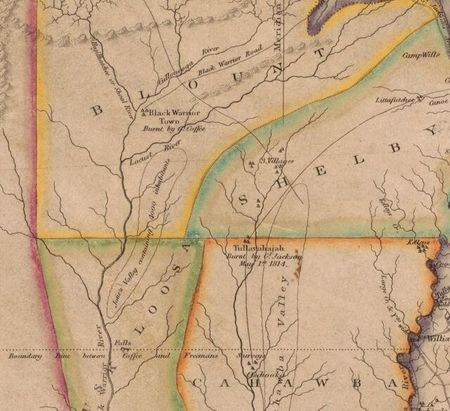Black Warrior Town
Black Warrior Town, or Black Warrior's Town, was a Creek settlement located on the east bank of the Sipsey Fork near its outlet into Mulberry Fork, near Old Town Creek and east of present-day Sipsey. It is often confused with another settlement established in 1809 at the Falls of the Black Warrior within Choctaw territory, which served as a station on the canoe route to St Stephens in Washington County.
According to Andrew Jackson's 1816 letter to John Coffee, the Creeks at Black Warrior Town were refugees from a Chickamauga village called Coldwater Town at Tuscumbia landing on the Tennessee River, which was destroyed by the Tennessee Militia under General James Robertson in June 1787.
By 1811 the chief of Black Warrior Town and founder of the outpost was Oceoche Emathla. In October of that year he hosted the Shawnee leader Tecumseh and his brother, Tenskwatawa, who were seeking support for a broad Native alliance against American frontier settlement. Tecumseh's party had been forced out of Choctaw lands to the west. For the most part, the Creeks and neighboring Choctaw, Chickasaw and Cherokee communities dismissed Tecumseh's appeals. Many Upper Creeks, however, were swayed by Tecumseh. A party traveled with him back to Ohio over the winter.
In May 1812 a small band of five Creeks led by Little Warrior, who had traveled north with Tecumseh, raided the homestead of Jesse Manley on the Duck River in Humphreys County, Tennessee. They killed seven people there and abducted a woman named Martha Crawley, who was brought back to the outpost at the Falls of the Black Warrior. A trader and blacksmith well-known to the Creeks, Tandy Walker, negotiated for her release and brought her safely to the household of George Gaines at St Stephens. Meanwhile a group of Cherokees reportedly hunted down the guilty Creeks.
Attacks by "Red Stick" Upper Creeks like the one at Duck River and the much-publicized "Fort Mims massacre" in August 1813 led Tennessee Governor Willie Blount to raise a large militia under the command of Andrew Jackson to destroy the Creek Confederacy, escalating what is now known as the Creek War. Black Warrior Town was burned in October 1813 by forces commanded by John Coffee. Davy Crockett was a private soldier serving under Coffee and recorded the incident in his memoir:
"We pushed on till we got to what was called the Black Warrior’s town, which stood near the very spot where Tuscaloosa now stands, which is the seat of government for the State of Alabama. This Indian town was a large one; but when we arrived we found the Indians had all left it. There was a large field of corn standing out, and a pretty good supply in some cribs. There was also a fine quantity of dried beans, which were very acceptable to us; and without delay we secured them as well as the corn, and then burned the town to ashes ; after which we left the place. In the field where we gathered the corn we saw plenty of fresh Indian tracks, and we had no doubt they had been scared off by our arrival."
Crockett's error in placing Black Warrior Town at the "Falls of the Black Warrior" site where Tuscaloosa was chartered in December 1819 has exacerbated what was already a confusing history.
On January 7, 1814 a force of 600 Chickasaw and Choctaw who were allied with the United States marched to the Falls of the Black Warrior Town under the command of John McKee and John Pitchlynn. Like Coffee's forces they found the settlement abandoned and burned the vacant structures to the ground.
References
- Crockett, David (1834) Narrative of the Life of David Crockett of the State of Tennessee Philadelphia, Pennsylvania: E. L. Carey & A. Hart., p. 83-84
